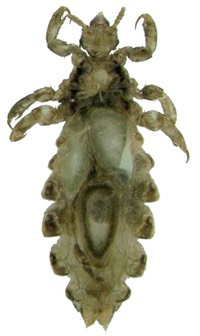Book, bark, beggar’s and sea ‘lice’ are each quite unrelated to lice that infest or bite people and other animals. Book and bark lice are insects commonly found in organic material such as leaf litter, under tree bark, and often within the pages of old books and papers. An object, the size of a period, walking across the printed page, is likely to be a book louse. One may emulate an editor and bring the creature to a ‘full stop’ with the use of a fingertip. Book lice may become particularly abundant indoors during the warmer and more humid months of the year. They can cause damage to books but are considered pests mainly in library archives. Their populations may be reduced by use of air conditioners and dehumidifiers. Book and bark lice are frequently submitted for identification as presumed parasites. Their presence on a person’s body is merely incidental; they do not parasitize people.
Diverse types of plant seeds adhere to clothing and hair, and are commonly termed beggar’s lice. Some insects related to aphids are known as plant lice. Certain parasites of fish are known as sea lice, but this term is often misapplied to a condition known as seabathers’ eruption that seasonally affects bathers along the seacoasts (caused by contact with stinging cells of certain comb jellies).


